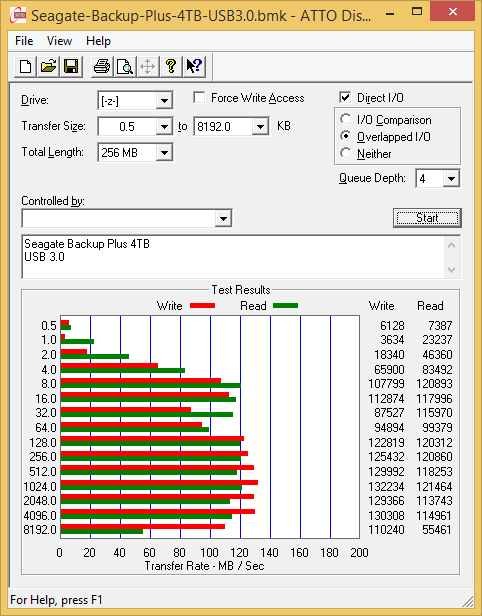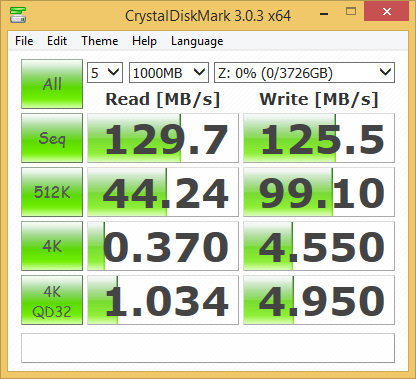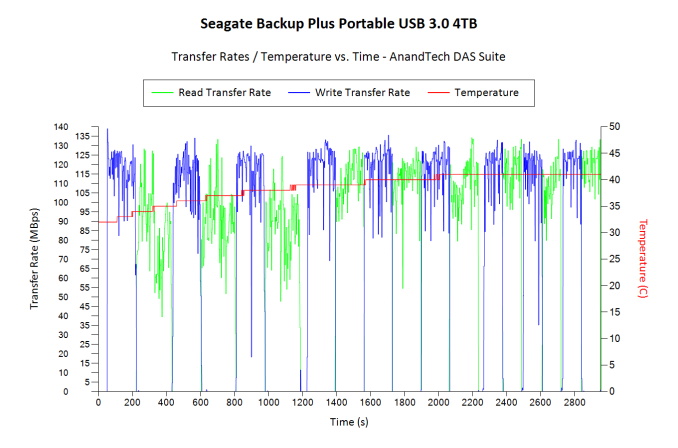Seagate Backup Plus Portable 4TB USB 3.0 Drive Review
by Ganesh T S on August 4, 2015 8:00 AM ESTDAS Benchmarks
The Backup Plus Portable 4TB drive came pre-formatted in NTFS. The root folder also had setup files that opened up the default browser for registering the device / downloading the value-add software (Lyve / Seagate Dashboard). Mac users can also download a NTFS driver for their system, making the unit truly portable across multiple operating systems.
In order to evaluate the DAS aspect of the Backup Plus Portable, we utilized the testbed outlined in the table below to test the performance. One of the USB 3.0 ports hanging off the PCH was used to connect the unit.
| AnandTech DAS Testbed Configuration | |
| Motherboard | Asus Z97-PRO Wi-Fi ac ATX |
| CPU | Intel Core i7-4790 |
| Memory | Corsair Vengeance Pro CMY32GX3M4A2133C11 32 GB (4x 8GB) DDR3-2133 @ 11-11-11-27 |
| OS Drive | Seagate 600 Pro 400 GB |
| Optical Drive | Asus BW-16D1HT 16x Blu-ray Write (w/ M-Disc Support) |
| Add-on Card | Asus Thunderbolt EX II |
| Chassis | Corsair Air 540 |
| PSU | Corsair AX760i 760 W |
| OS | Windows 8.1 Pro |
| Thanks to Asus and Corsair for the build components | |
The full details of the reasoning behind choosing the above build components can be found here.
Our testing methodology for DAS units takes into consideration the usual use-case for such devices. The most common usage scenario is transfer of large amounts of photos and videos to and from the unit. The minor usage scenario is importing files directly off the DAS into a multimedia editing program such as Adobe Photoshop. Prior to taking a look at the real-life benchmarks, we first check what ATTO and CrystalDiskMark have to report for the Backup Plus Portable 4TB drive.
In order to tackle the first real-life use-case, we created three test folders with the following characteristics:
- Photos: 15.6 GB collection of 4320 photos (RAW as well as JPEGs) in 61 sub-folders
- Videos: 16.1 GB collection of 244 videos (MP4 as well as MOVs) in 6 sub-folders
- BR: 10.7 GB Blu-ray folder structure of the IDT Benchmark Blu-ray (the same that we use in our robocopy tests for NAS systems)
| Seagate Backup Plus Portable 4TB robocopy Benchmarks (MBps) | ||
| Write Bandwidth | Read Bandwidth | |
| Photos | 94.57 | 78.18 |
| Videos | 99.02 | 97.74 |
| Blu-ray Folder | 93.36 | 99.64 |
The above benchmark run was also instrumented to record the drive temperature as well as instantaneous transfer rates during the process. The internal disk temperature was only slightly more than 40 C even after more than 127 GB of writes and 127 GB of reads continuously.
For the second use-case, we take advantage of PC Mark 8's storage bench. The storage workload involves games as well as multimedia editing applications. The command line version allows us to cherry-pick storage traces to run on a target drive. We chose the following traces.
- Adobe Photoshop (Light)
- Adobe Photoshop (Heavy)
- Adobe After Effects
- Adobe Illustrator
Usually, PC Mark 8 reports time to complete the trace, but the detailed log report has the read and write bandwidth figures which we present in our performance graphs. Note that the bandwidth number reported in the results don't involve idle time compression. Results might appear low, but that is part of the workload characteristic. This is not the intended use-case for portable hard drives, but the results are just presented here for the sake of completeness
| Seagate Backup Plus Portable 4TB PCMark8 Storage Benchmarks (MBps) | ||
| Write Bandwidth | Read Bandwidth | |
| Adobe Photoshop (Light) | 91.07 | 4.17 |
| Adobe Photoshop (Heavy) | 124.95 | 5.37 |
| Adobe After Effects | 82.20 | 4.18 |
| Adobe Illustrator | 141.41 | 4.08 |
In the next section, we will take a look at the value-add features and provide some concluding remarks.













47 Comments
View All Comments
fjcamry - Tuesday, August 11, 2015 - link
I have a 2 TB Seagate external drive in a enclosure with holes. I can tell it's running cool while the computer is on with Seagate dashboard always on start up. I turn off the computer when done using it , maybe leaving it on Sunday for scheduled backups. I used to have a motherboard program showing how many rpms the drives all ran at. That was with another system that I built. So my question is how can I see how many rpms my external drive is without having to search for a third party monitoring program to download and install? I've searched everything I know of on my windows 10 upgrade.darkfalz - Tuesday, August 18, 2015 - link
I have some 7200 RPM 3TB Expansion Desktop drives, they ran so hot I had to put a fan on them during extended file operations. The same enclosure 4TB / 5900 RPM run much cooler.prisonerX - Tuesday, August 4, 2015 - link
It's just you. Besides the marketing boost for the latest standard, it makes no sense relying on a standard that is superseded and being phased out. As the whole industry rolls forward new parts not only support the latest standard but are also lower power, have bug fixes and other performance improvements built in. Parts for the old standard become harder to find and more expensive over time and even if your product has a normal life cycle it's possible that the older part may no longer be available, which would immediately kill a possibly successful product.ddriver - Tuesday, August 4, 2015 - link
It might still be beneficial when transferring data that would fit in the HDD cacheCharonPDX - Tuesday, August 4, 2015 - link
Because most chipsets are now SATA3. Why bother creating a SATA2 chipset, or using an old, likely discontinued SATA2 chipset, when a SATA3 chispet is readily available and cheap?Daniel Egger - Tuesday, August 4, 2015 - link
I'm actually surprised that they still do SATA and add a SATA<->USB bridge. I recently bought a Toshiba drive (actually with the purpose to rip the case apart and use the SATA drive internally as backup) to find out that Toshiba got rid of SATA altogether and packed USB 3.0 directly on the drives mainboard.darkfalz - Tuesday, August 18, 2015 - link
I'm sure the few cents they save on the bridge chip would be lost having two separate PCB manufacturing runs.Cptn_Slo - Tuesday, August 4, 2015 - link
I think since USB 3 came out well after the wide adoption of SATA 3 no one has bothered to design a sata 2 to usb 3.0 interface.since there is a noticeable difference between usb 2 and 3 everyone just stuck with sata 3.
also sata 3 is probably cheaper on the drive side.
to do a sata 2 drive is a lot of work on the manufacturing side with 0 benefits.
hlmcompany - Tuesday, August 4, 2015 - link
USB 3.0 provides more power to the device. For these portable devices, it isn't just about data transfer speed, it's also about being sure the device has enough power. Of course this is host dependent. So, if the host is USB 2.0, power can still be an issue and a dual Type-A connector may be needed.Guspaz - Tuesday, August 4, 2015 - link
How can you not tear that sucker open? We must see the drive inside!